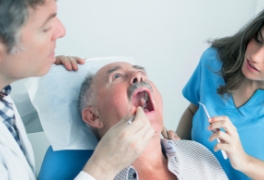News & Updates
Oral Cancer Updates
When it comes to oral cancer, early detection is key. According to the Oral Cancer Foundation, approximately 53,000 people in the United States will be diagnosed with oral or oropharyngeal cancer this year, and it will cause more than 9,750 deaths. On average, 57% of those diagnosed with the disease will survive more than five years. When found in early stages, oral cancers can have an 80-90% survival rate. However, the majority are found as late-stage cancers when they may have spread to other locations, such as the lymph nodes in the neck area.

Regular dental checkups that include an examination of the entire head and neck can be vital in detecting cancer early. It’s important to talk to your dentist if you’ve had any changes in your medical history or if you’ve been experiencing any new or unusual symptoms.
As part of an oral cancer screening, your dentist will check your oral cavity—including your lips, cheek lining, gums, the front part of your tongue, the floor of your mouth, and the roof of your mouth. He or she also will examine your throat at the soft part at the roof of your mouth, including your tonsils, the back section of your tongue, and where your tongue attaches to the bottom of your mouth. The dentist will then feel your jaw and neck for any lumps or abnormalities.
Self Exams
You can take an active role in detecting signs of oral cancer by taking a few minutes, once a month, to examine your lips, gums, cheek linings, tongue, and the floor and roof of your mouth.

To perform a complete oral cancer self-exam, use a bright light and a mirror to:
- Look for any white or red spots inside your lips and around the inside of your cheeks
- Pull your lip out to look for any raised or thickened areas at the front and inside of your gums
- Lift your head back to inspect the roof of your mouth, feel with your forefinger for any bumps or growths, and look for any color changes that are evident
- Take a clean gauze or tissue and gently pull your tongue out to view all surfaces on it to observe if there are any color changes or if any red or white lesions are present
- Feel for lumps in the neck and lower jaw region on both sides
While oral cancer self-exams should be considered a secondary, preventive technique in detecting early lip and mouth lesions, they should never take the place of a professional exam. So be sure to visit your dentist twice a year for regular checkups and a thorough oral cancer screening.